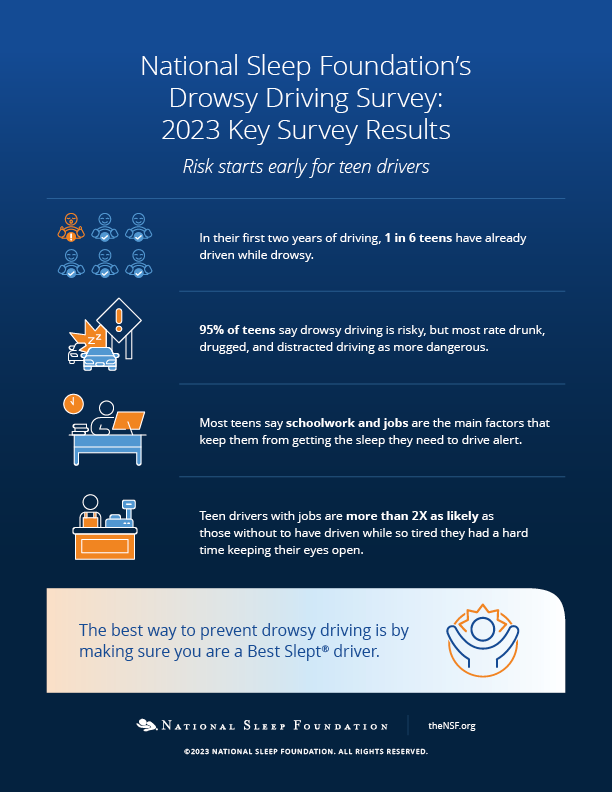Study Results Show Drowsy Driving Begins During Teen Years
For Immediate Release
Media Contact:
Stephanie Kohn
skohn@theNSF.org
National Sleep Foundation Study Results Show Drowsy Driving Begins During Teen Years
New survey of teen drivers shows attitudes and actions about impaired driving, implications for sleep health
Washington, D.C. (November 2, 2023) – Today, the National Sleep Foundation (NSF) released results of a new survey of American teens highlighting their attitudes and behaviors about drowsy driving. Teens reported driving drowsy at high rates, especially considering their status as new drivers. Teens also said school and job commitments were the top factors keeping them from getting the sleep they need to drive alert. A corresponding NSF survey of US adult drivers showed similar results about the top contributors to their drowsiness behind the wheel but with greater frequency of driving while drowsy. Teens and adults called drowsy driving “highly risky.”
National Sleep Foundation’s 2023 Drowsy Driving Survey was fielded as part of Drowsy Driving Prevention Week®, NSF’s annual campaign to help Americans get the sleep they need and reduce the number of drivers who get behind the wheel while sleep-deprived. NSF urges everyone to Sleep First. Drive Alert.TM
Drowsy driving is a public health issue linked to thousands of car crashes each year, killing an estimated 6,400 people annually in the U.S. alone, according to the AAA Foundation for Traffic Safety. NSF and other expert sources believe crash and fatality data are likely underestimated. NSF’s 2023 survey data show drowsy driving is common among American adults, where six in ten adult drivers admit to having driven a car when they were so tired they had a hard time keeping their eyes open. These findings are consistent with NSF’s 2022 results, reinforcing the ongoing need for education about the importance of sleep health.
Key results from teen drivers, featured this year, showed
- In their first two years of driving, 1 in 6 teens have already driven while drowsy.
- 95% of teens say drowsy driving is risky, but most rate drunk, drugged, and distracted driving as more dangerous.
- Most teens say schoolwork and jobs are the main factors that keep them from getting the sleep they need to drive alert.
- Teen drivers with jobs are more than 2X as likely as those without to have driven while so tired they had a hard time keeping their eyes open.

“Other science and research previously established teens and young people are at high risk for drowsy driving. What we see in our results this year is many teens, early in their driving experience, say they’ve already driven while drowsy. Overall, teens know the risks of drowsy driving, but don’t think it’s as risky as other forms of impaired driving,” said Joseph Dzierzewski, PhD, Vice President, Research and Scientific Affairs, National Sleep Foundation. “The good news is – drowsy driving is preventable, and there’s a lot we can teach our young drivers about the importance of getting the sleep they need before they get behind the wheel.”
There are steps people can take to help lessen the risk
- Get the recommended amount of sleep before you drive
- While the feeling of a good night’s sleep varies from individual to individual, NSF recommends 7-9 hours of sleep per night for adults and 8-10 hours for teens of driving age.
- Plan your long trips with a companion
- A companion passenger can not only help look for early warning signs of drowsiness but also help with driving when needed. A good driving companion is someone who stays awake to talk to you and will be aware of your alertness.
- Schedule regular stops for your trip, every 100 miles or two hours
- Be mindful of warning signs of drowsy driving
- Frequent blinking and yawning or having difficulty with lane and speed control are common signs that you may be driving while drowsy.
“At NSF, we’re dedicated to helping everyone prioritize their sleep for health and safety,” said John Lopos, CEO, National Sleep Foundation. “Getting enough quality sleep to be your Best Slept Self® is also important for our safe driving and responsibility on the road.”
NSF independently produces Drowsy Driving Prevention Week® and all related official educational content. Drowsy Driving Prevention Week 2023 sponsors include Waymo, Schneider National, General Motors, Samsung Health, Eisai Inc., and Asleep. Visit the NSF website to see a full list of collaborators for the 2023 Drowsy Driving Prevention Week campaign, including the Autonomous Vehicle Industry Association, National Alliance to Stop Impaired Driving, and Governors Highway Safety Association.
Join NSF to help prevent drowsy driving by sharing the campaign’s message on social media using the hashtag #SleepFirst. NSF’s drowsy driving prevention resources are available on www.theNSF.org.
###
About the National Sleep Foundation
The National Sleep Foundation (NSF) is a 501(c)3 nonprofit corporation dedicated to improving health and well-being through sleep education and advocacy. Founded in 1990, the NSF is committed to advancing excellence in sleep health theory, research and practice. theNSF.org │ SleepHealthJournal.org
